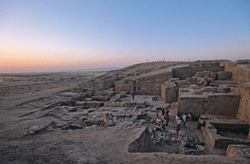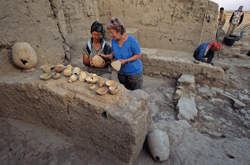
Posted on 06/25/2008 6:23:45 PM PDT by blam
Who Were the Hurrians?
Volume 61 Number 4, July/August 2008
New discoveries in Syria suggest a little-known people fueled the rise of civilization

Excavations at the 3rd millennium city of Urkesh in Syria are revealing new information about the mysterious people who lived there, known as the Hurrians. This view of the city's royal palace shows the service area (left) and living quarters (right). (Ken Garrett)
With its vast plaza and impressive stone stairway leading up to a temple complex, Urkesh was designed to last. And for well over a millennium, this city on the dusty plains of what is now northeastern Syria was a spiritual center for a puzzling people called the Hurrians. All but forgotten by history, their origin remains obscure, but excavations led by husband-and-wife UCLA archaeologists Georgio Buccellati and Marilyn Kelly-Buccellati over the past quarter century reveal that the Hurrians were far more than just another wandering tribe in the fractious Middle East. And during last year's season, they found compelling evidence that the Hurrians not only strongly influenced the language, culture, and religion of later peoples, but also may have been present 1,000 years earlier--just as nearby Mesopotamians began to create the first cities.

Archaeologist Giorgio Buccellati has been leading excavations at Urkesh for nearly 20 years. (Ken Garrett)
That idea is at odds with a long-held belief among scholars that the Hurrians arrived much later from the Caucasus or some other distant region to the northeast, drawn to the fringes of civilization after the rise of the great southern Sumerian centers of Ur, Uruk, and Nippur. Scholars long assumed that the Hurrians arrived in the middle of the third millennium B.C., and eventually settled down and adopted cuneiform as a script and built their own cities. That theory is based on linguistic associations with Caucasus' languages and the fact that Hurrian names are absent from the historical record until Akkadian times.

Project ceramicist Marilyn Kelly-Buccellati (right) examines vessels with volunteer archaeologist Mary Stancavage, in the area of the palace where all the pieces were unearthed. (Ken Garrett)
But Piotr Michaelowski, an Assyriologist at the University of Michigan, notes that Hurrian, like Sumerian, is a language unrelated to Semitic or Indo-European tongues that dominated the region during and after the third millennium B.C. Perhaps, he suggests, the Hurrians were earlier inhabitants of the region, who, like the Sumerians, had to make room for the Semitic-speaking people who created the world's first empire based at Akkad in central Mesopotamia around 2350 B.C.
The discovery of a sophisticated city with monumental architecture, plumbing, stonework, and a large population contradicts the idea that Hurrians were a roving mountain people in a strange land. Far from being yet another rough nomadic tribe, such as the Amorites or Kassites who were latecomers to the Mesopotamian party, the Hurrians and their unique language, music, deities, and rituals may have played a key role in shaping the first cities, empires, and states. The language has died, the music faded, and the rituals are forgotten. But thanks to the sculptors, stone masons, and seal carvers at Urkesh, Hurrian creativity can shine once again.
GGG Ping.
They were the forebears of the Russians.
Did the Hurrians have waiters?
So why are the Hurrians always named alphabetically.
Several thoughts here:
1. Clearly, this merits a lot more research. There must be no delay in digging up every square inch of Syria, and I think we should extend that to the Bekaa Valley. Upside down and inside out. Important for the advancement of knowledge, don’t you know.
2. Since these people are extinct, we can tell ethnic jokes about them. Did you hear the one about the two Hurrian guys in the elevator?
3. I’m not sure I’d tell people I was an Assyriologist.
People who walked around very fast?
I thought they were some Indians from around the Great Lakes somewhere.
bookmark
In inscriptions of the Assyrian King Shalmaneser I (1280-1261 B.C.) we find the first occurrence of the term Uruatri... eight countries, collectively referred to as Uruatri, situated in a mountainous region to the southeast of Lake Van... the Assyrian name of Uruatri had no ethnic significance... (perhaps meaning 'the mountainous country')... In Assyrian inscriptions of the 11th century B.C., we again find the term Uruatri, and from the second quarter of the 9th century, in the reign of Ashurnasirpal II (883-859 B.C.), it is of common occurrence, in the form Urartu, being used concurrently with the name of Nairi... (Boris B. Piotrovsky, Urartu pp 43-45)the web archive version:
The author of the following is another "Aryan" flake.In Search of Hurrian UrkeshWe know that Urkesh was... a real city as well. In 1948, two bronze lions appeared on the antiquities market; the lions are inscribed with a text in which a king by the name of Tish-atal boasts of having built a temple in Urkesh. But since the provenance of these lions is not known, the location of the city until recently was also unknown... Our excavations, however, have proved that Urkesh was located at the remote north Syrian site of Tell Mozan.
by Giorgio Buccellati
and Marilyn Kelly-Buccellati
Proto-Indoaryans, Mitanni, HurriansHurrian texts maintained in the Hittite archives, coupled with Hurrian loan words in Luwian and the Hurrians' own inscriptions and texts in north Mesopotamia which date as early as the twenty-third century BC, all speak for an additional non-Indo-European presence on the eastern borders of the Indo-Europeans of Anatolia..."(J.P. Mallory, In Search of the Indo-Europeans: Language, Archaeology and Myth, London, Thames and Hudson, 1989).
There is a great number of Hurrian gods mentioned in Hittite texts, and many of these are descriptions of cult festivals. Since most texts are fragmentary and, therefore, cannot be dated exactly, we only pick a few significant examples. The texts for the his'uwa festival have just been mentioned. Most revealing is a prayer of king Muwatalli. Already in the invocation of the main gods at the beginning of the text, Hebat occurs. The king then asks the bull S'eris' to intercede for him, and calls him 'Bull of the Weathergod of Hatti', which means that this Hurrian bull had entered the circle of the gods of the capital." (Guterbock, H.G., The Hurrian Element in the Hittite Empire, in: Hoffner, Jr., Harry A. (ed.), Perspectives on Hittite CIvilization: selected writings of Hans Gustav Guterbock, Chicago, Oriental Institute of the University of Chicago, 1997)
Archaeologists say the Urartians failed to overcome harsh winter conditions
Turkish Daily News | Friday, March 3, 2006 | Dogan Daily News
Posted on 03/03/2006 8:19:01 AM PST by SunkenCiv
http://www.freerepublic.com/focus/f-chat/1589276/posts
Lycian Influence To The Indian Cave Temples
The Guide to the Architecture of the Indian Subcontinent | spring of 2000 | Takeo Kamiya
Posted on 07/11/2005 10:37:19 PM PDT by SunkenCiv
http://www.freerepublic.com/focus/f-chat/1440990/posts
Capital City Of Ancient Superpower Discovered (Medes)
Independent (UK) | 10-26-2002 | David Keys
Posted on 10/26/2002 12:56:48 PM PDT by blam
http://www.freerepublic.com/focus/f-news/776390/posts
 |
||
| · join · view topics · view or post blog · bookmark · post new topic · | ||
These guys are credited with being the first people to bring domesticated horses to Mesopotamia.
The Iranians have recently found/redated ruins to this earlier period ~
|
|
|||
Gods |
Thanks Blam. |
||
|
· Mirabilis · Texas AM Anthropology News · Yahoo Anthro & Archaeo · · History or Science & Nature Podcasts · Excerpt, or Link only? · cgk's list of ping lists · |
|||
Don't know.
But for all their hurrian, they still aren't here.
|
http://en.wikipedia.org/wiki/Hurrians#Language
The Hurrians spoke an ergative-agglutinative language, conventionally called Hurrian, unrelated to neighboring Semitic or Indo-European languages, but clearly related to Urartian — a language spoken about a millennium later in northeastern Anatolia — and possibly, very distantly, to the present-day Northeast Caucasian languages. Some scholars relate the Hurrian language also to Georgian and its associated South Caucasian or Kartvelian languages.[3] Similarities to Hurrian words have also been suggested in neighboring languages such as Armenian.[4][5] It is believed by some scholars that the Hurrians arrived in the Caucasus around 2700 BC.[6]
The Hurrians adopted the Akkadian cuneiform script for their own language about 2000 BC. This has enabled scholars to read the Hurrian language. Because the number of Hurrian texts discovered is small, and because many Sumerian logograms are used, masking the phonetic shapes of the Hurrian words they represent, understanding of the Hurrian language is far from complete and many words are missing from their vocabulary.
Texts in the Hurrian language have been found at Hattusa, Ugarit (Ras Shamra), as well as one of the longest of the Amarna letters, written by King Tushratta of Mitanni to Pharaoh Amenhotep III. It was the only long Hurrian text known until a multi-tablet collection of literature in Hurrian with a Hittite translation was discovered at Hattusas in 1983.
According to medieval Islamic sources, the language spoken by Hurrian tribes that primarily belonged to the Yazdanism sect of religious belief spoke a Proto-Pehlewani language.[7] The Hurrian influence on the modern Kurdish language is still evident in its ergativic grammatical structure and in its toponyms.[8]
People who walked around very fast?
Yes, they were always rushed, and their favorite symbol was a red bull.
This tends to overshadow Hurrian grammar, particularly since the largest body of Hurrian literature was actually translated into a different language.
This all took place before most Indo-European languages had solidified into their current forms.
We were just discussing the Druze last week. Early Druze made their living as "scribes". They failed to preserve even the slightest element of their original language, particularly as they acquired all the good lookin' chicks from all the major tribes and nations in the Middle East!
Being a scribe was a doggone good job!
When I was Hurrian to get home, Iran :-)
Disclaimer: Opinions posted on Free Republic are those of the individual posters and do not necessarily represent the opinion of Free Republic or its management. All materials posted herein are protected by copyright law and the exemption for fair use of copyrighted works.